Guide to Waterproof and Water-Resistant Hearing Aids
You don’t have to be an avid swimmer, scuba diver, surfer, or whitewater rafter to benefit from waterproof hearing aids.
Waterproof hearing aids are ideal for anyone.
They offer genuinely effective protection from accidental spills or submersion, sweat, dust, and other contaminants.
This makes hearing aids more convenient to wear and more dependable to use in a wide range of conditions.
If you are looking for hearing aids that can withstand getting accidentally dunked in the swimming pool or go the distance in a humid summer marathon without succumbing to moisture damage, this post is for you!
The truth about waterproof hearing aids
The truth is, despite marketing claims, fully waterproof hearing aids don't exist.
Even the best waterproof hearing aid available (details below), is not actually 100% waterproof.
That's because there's a part on the hearing aid that will fail when it's exposed to water.
It's a small part, and for most people it's easily replaceable, but still- it'll fail.
So should the hearing aid actually be called waterproof?
I don't know.
But what I do know, is if you get a waterproof hearing aid, you shouldn't expect for it to hold up without some maintenance.
...and you should probably still try to avoid water.
Hearing aid IP ratings
If water resistance is important to you, then when you buy hearing aids you should pay attention to the hearing aid's IP rating.
An IP rating is an international standard which measures a hearing aid’s ability to withstand potential harm from solid contaminants and moisture.
An IP rating is a two digit rating, with the first digit representing ingress protection for solids (how well the hearing aid keeps them out), and the second digit representing protection from the effects of moisture.
The two digits are not directly related- one may go up, while the other goes down.
The abbreviated table below defines the amount of protection from dust and water for a given IP rating.
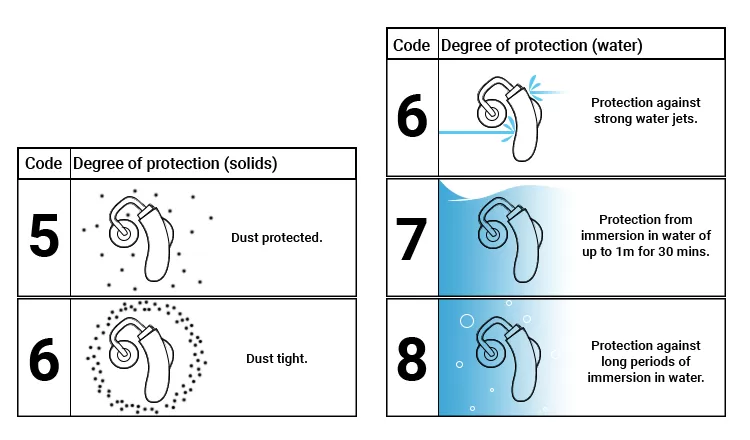
As an example, based on the table above, an IP 68 hearing aid would be considered “dust-tight” and protected against “long periods of immersion in water.”
IP68 is the highest IP rating a device can have, and luckily, it’s a rating that many of the most popular hearing aids today have.
You can check the IP rating of any hearing before you buy it by reviewing the specifications on the manufacturer's website.
The best waterproof hearing aid
In recent years, hearing aid manufacturers have softened their claims, now favoring the label “water-resistant” over “waterproof”.
For that reason, it's easy to say who makes the best waterproof hearing aid, because there's only one company bold enough to call their product waterproof.
The best waterproof hearing aid is Phonak Audéo Lumity Life.
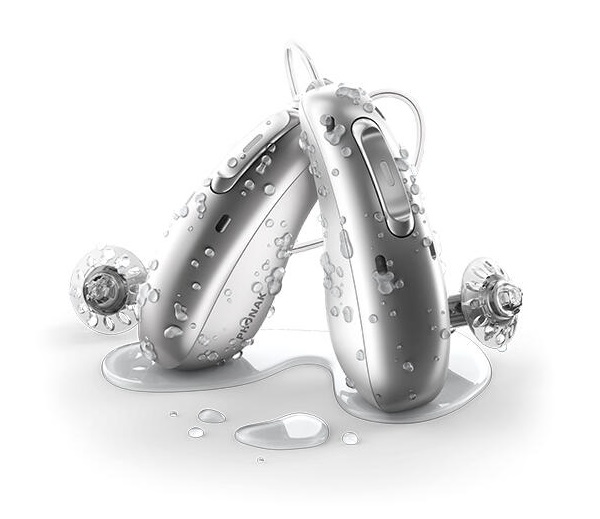
Phonak Audéo Lumity comes in a few different models/form factors. The 'Life' model is simply the waterproof variation of the Phonak Audéo Lumity hearing aid.
It offers all the same features as the other models in that family, including direct Bluetooth connectivity to smartphones and lithium-ion rechargeability.
Audéo Lumity is a well-reviewed hearing aid and can easily be considered one of the top 5 prescription hearing aids on the market.
The fact that the 'Life' variant is waterproof is just icing on the cake of an already good hearing aid.
But you can't just get Audéo Life anywhere.
Phonak recommends you purchase this hearing aid locally, from a trained Phonak hearing aid specialist who can ensure it's fit and programmed correctly.
If you don't know where to get this locally, you can find out here.
There are four different technology levels (AKA quality levels) of this hearing aid, and prices vary drastically.
You can expect to pay between $1998-$7500 for a pair of these hearing aids.
Just how waterproof are they?
Phonak says they've tested this hearing aid extensively beyond the normal IP 68 rating to withstand being submerged in up to 1.64 feet of fresh water, salt water, or pool water.
We know that models that underwent the usual IP 68 rating testing could easily withstand submersion in water up to 15 minutes, so if Audéo Life is better than that, these should be pretty hard to kill.
But...
There's the issue of the receiver wire (speaker).
This is true of all hearing aids — the receiver wire does not hold the same IP rating of the hearing aid.
That means if you were to (for example), swim laps for 30 minutes with these hearing aids, they'd most likely give out as a result of the receiver taking on water.
It's not the end of the world because receivers can be easily replaced without a visit to your hearing care provider, but at the same time, it's not as though Phonak gives out a never-ending supply of receivers.
If you're thinking, "okay, I'll just replace the receiver every time I swim," Phonak is likely to shut that down real quick.
This is why I said at the top, I'm not so sure I'd call this hearing aid "waterproof."
It's certainly the most water-resistant hearing aid available, but waterproof?
I'm not so sure.
How to protect hearing aids from water
Even the best water-resistant hearing aids need preventive care and sometimes extra protection.
Water does not necessarily need to damage a hearing aid to get in the way.
For instance, it only takes a single drop of water that happens to bead directly over your microphone to dampen the conversation.
With in-the-ear hearing aids, earwax and moisture in the receiver end, at the tip of the aid, are common sources of aggravation.
A familiar scenario with behind-the-ear hearing aids is when a stubborn drop of condensation forms in the earmold tubing, blocking the opening. A puff of air through the tubing discharges the condensation easily enough, but only to return again in a matter of minutes.
Any water that sticks around like this poses a risk to the hearing aids, sooner or later.
Water-resistant hearing aids feature interior protection, such as nano-coating, and exterior protection, such as sealed buttons or switches. Likewise, you can add or enhance your own internal and external water protection.
The best way to protect hearing aids from the inside out is to use them where the air is dry. This is not always possible, but what you can do is limit how long humid air hangs around, by treating your hearing aids to their own dehumidifier.
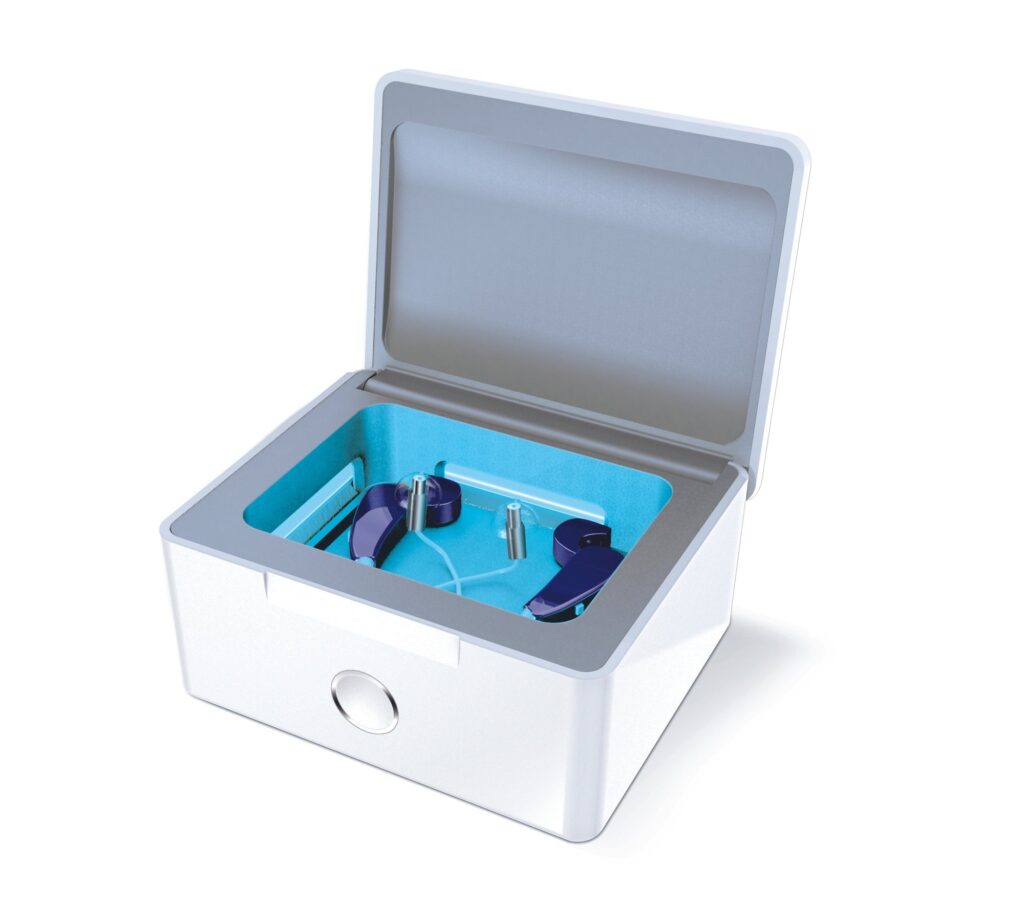
Passive desiccant pellets, usually made of silica, are another option for drying hearing aids at the end of the day or any time your hearing aids are not in use.
Passive desiccants may not dry as quickly or effectively, compared to active dryers, but getting the job done for a fraction of the price.
Dry, uncooked rice also works as a desiccant. Maybe just as well as commercial products. However, commercial desiccants usually change color when saturated, making it easy to know if the desiccant is dry in the first place.
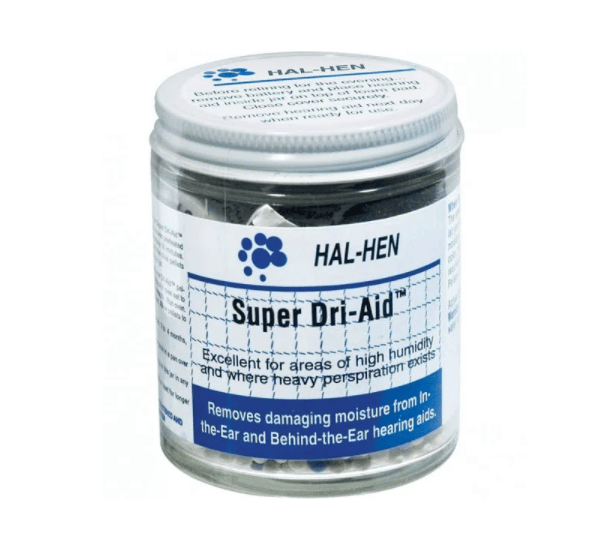
Just because hearing aids can survive getting wet, doesn’t mean you won’t want to protect and keep them dry when possible.
Putting your hearing aids inside a protective cover keeps them clean and preserves their finish.
This is a smart option for anyone who wears hearing aids while exercising, working outside, playing sports, and so on.
Ear Gear (shown below) is one of the most popular options for protecting your hearing aids from water.
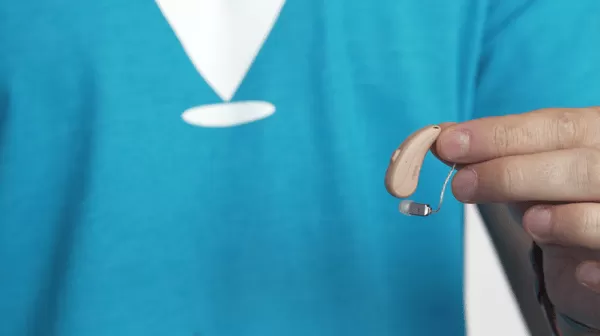
Ear Gear hearing aid covers give you a lot of options, including custom designs, with a specific fit for a wide range of hearing aids and accessories.
The spandex material comes in traditional, colorful, camouflage, or animal-print colors, and you can choose whether to include a cord and retention clip for attaching the covers to your clothing.
Ear Gear’s website features a handy fit list, where they list all the latest hearing aids, and the corresponding correct size Ear Gear product to order.
What to do if hearing aids get wet
Don’t panic! If your hearing aids have a high IP rating, they’re designed to be resilient in these situations.
1. First, turn the hearing aids off.
2. Next, rinse carefully with clean water if the aids were exposed to dirty, chlorinated or salty water. Leaving these contaminants on the hearing aids could lead to wear or corrosion later.
3. Dry the exterior of the hearing aids using a soft cloth, not hot or forced air. Don’t use a hairdryer.
4. Only after the hearing aids are dry on the outside, remove the batteries then leave the hearing aids open to fully dry inside and out. If the hearing aids stayed dry on the inside, they may be ready to use again right away.
5. When hearing aids get wet on the inside, getting them completely dry again takes a little more patience. However, an effective way to speed up the process and encourage damp hearing aids to dry completely is to enclose them in a container or plastic bag along with some uncooked rice or silica, which help draw out moisture.
The bottom line
The bottom line about hearing aids and water exposure, is exercise caution.
You shouldn’t go for a swim in your hearing aids, but you also shouldn’t avoid the rain in fear it’ll ruin your hearing aids.
The highest-rated ingress protection available in today’s hearing aids is IP68, so look for that rating when buying hearing aids.
Whether or not you consider it a priority to choose the highest IP rating, ingress protection provides peace of mind, making it easier than ever to enjoy wearing hearing aids.






